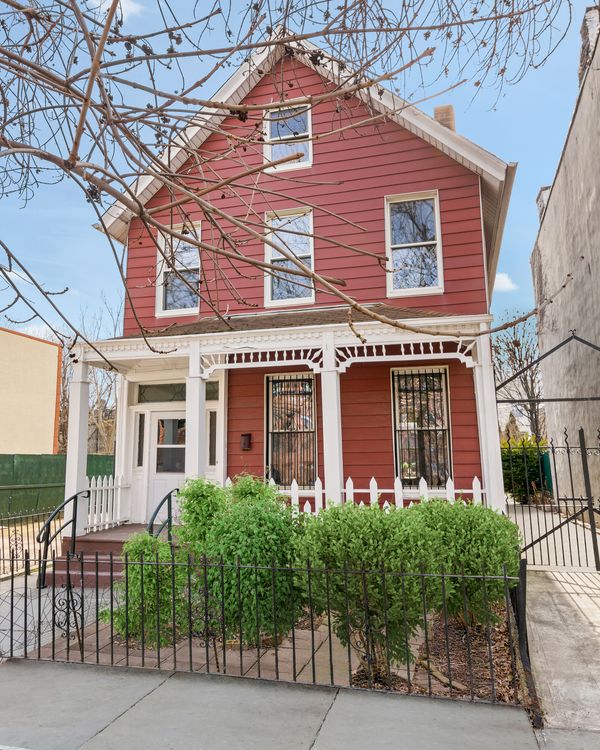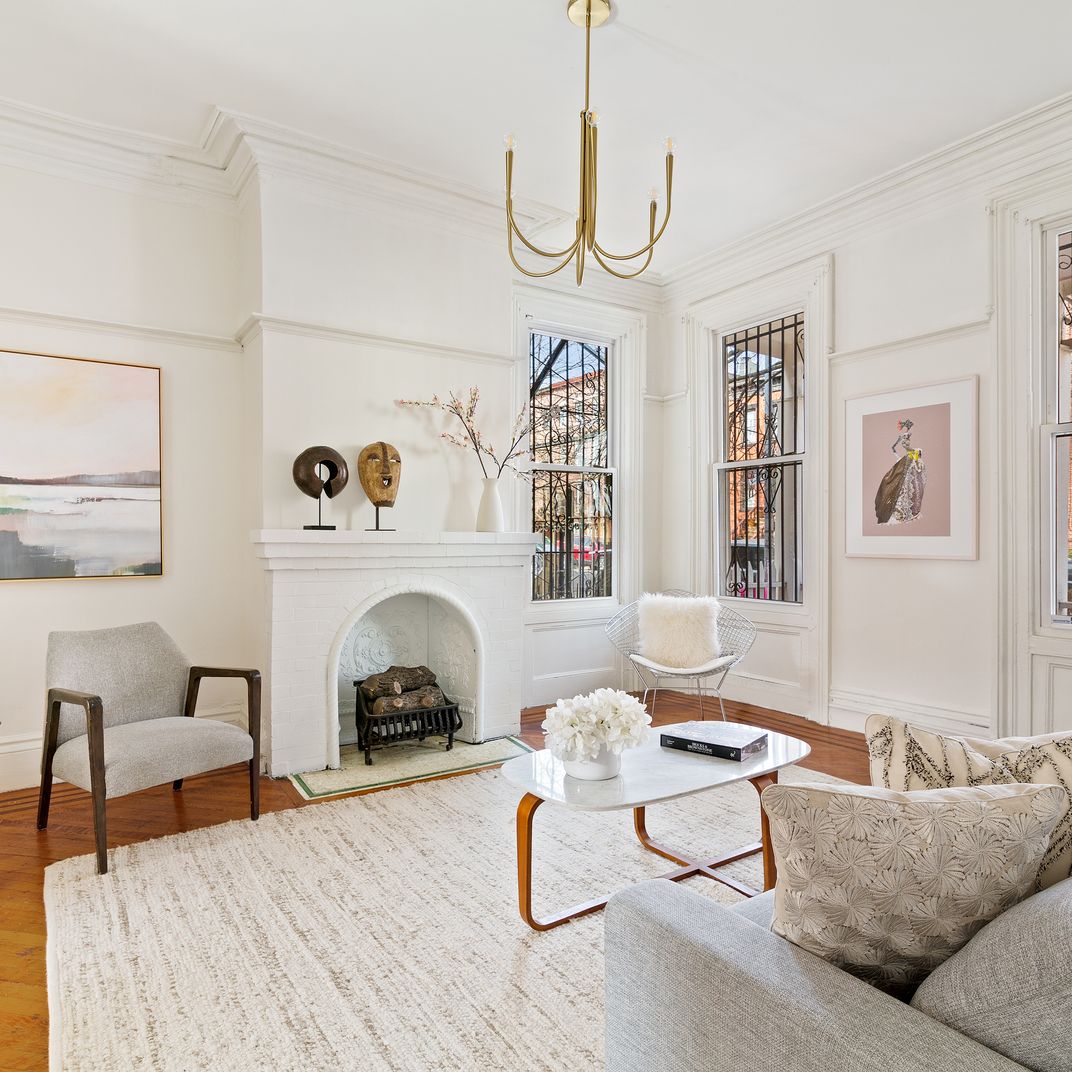
Situated between brownstones and condos, 170 Madison Street is a wood-frame, single-family house with a wide front porch — the kind of place you might not notice in a small town upstate. Last weekend, at its first open house, the $1.495 million listing drew crowds you’d expect at a gallery opening, despite issues with its flooring, electricity, and the fact the house doesn’t have central air. “I’ve had so many people through,” said Corcoran agent Tita Omeze, who estimated she had about 90 visitors over two days.
“It feels like a country home in the city,” said Omeze, who pointed out that there’s a real peach tree in the real backyard. There is also a finished attic, four fireplaces, wood floors, mantels, picture rails, a wood-fired stove, and frothy white trim. Some of that may be original to the earliest wave of development in Bed-Stuy: an 1880 map lists the house along with a “scattering” of other wood frames across the former Bedford family farm, according to the Brownstoner, which also uncovered some of the earliest owners: a white couple named Harry and Ida May, who lived there from 1890 to 1941. The Russell family — the same ones who are selling the house today — were likely the next owners. They took out a mortgage for the house around 1948 for $8,700, according to John Russell, now 82, who grew up in the house. He remembers growing up with neighbors who were Black, white, and Native American, like his father, who was half Cherokee.
As white families fled to the suburbs over the next decade, Russell saw the block change “from white predominantly to Black predominantly,” and hard times in the 1960s forced many of those Black owners to modify single-family houses. “They’d break a one family into two or three or four families, and add rooms to pay the bills,” Russell said. His own family took in a boarder for $25 a month, but didn’t change much about the house, except to tear down the garage so the kids would have more room to play. Russell’s siblings all gradually left. “Nobody wanted the house at that time. It was the ghetto. The houses were dilapidated around us. And my sisters and brothers wanted to spread their wings. They moved up, and I ended up with it myself.”
He had a good reason to stay: He fell in love with the girl across the street, Arlean, who became a nurse. Russell worked two jobs and went to school at night, eventually becoming a staff engineer for IBM. Meanwhile, the couple cared for his parents and raised three daughters, including Annette Sutton, now a 60-year-old paraprofessional for a New Jersey school. “When a child learns to draw a house they draw a triangle and then a square. That’s the house,” she said. “It didn’t seem like it belonged there. It was just different from every house on the block.” She remembered sliding down the banister, playing in the attic, and lingering on the porch. “We used to put the chairs on the porch and sit out there and watch our neighbors go by and talk to our neighbors,” she said.
Her father tried to maintain the house just as he’d loved it in his childhood. He kept a garden in the back, planting cherry tomatoes, zucchini, and squash this year, just like his mother would back in the 1950s. “It used to be open. I used to walk from yard to yard, apple to apple tree, pear to pear tree, climbing trees. My mother would make jelly preserves. Those were the days. We had collard greens, all kinds of gardens — each neighbor had a garden. You’d have breakfast with tomatoes and eggs from the garden.”
Many of the people at the open house were young white couples, looking to move to a quickly gentrifying neighborhood. Between 2010 and 2020, Bedford Stuyvesant lost 22,000 of Russell’s Black neighbors and added 30,000 white transplants, according to census data. Omeze, the agent, acknowledged that the house might very well go to some of those new white transplants. “Even though I’m Black and the owner’s Black, we can’t discriminate against white people,” she said. Russell, the 82-year-old owner, would be happy to give it to them, he says. As long as it stays a house. The current zoning would allow an owner to knock it down and build something more than twice as big, which is what the owners of 174 Madison, two doors down, appear to be doing with a permit to build yet another four-story neighbor. Still, he warns, the house has been a lot of work. “You do one thing, and in three months something else comes up. I did it all myself, and I got a lot of help.”
One of two downstairs parlors, lovingly maintained by the Russell family, who made small renovations — like adding bars over the downstairs windows when crime increased in the late 1960s.
The house comes with a whopping four fireplaces, some with original details that date back to the 19th century.
The house will need work. Omeze had downstairs carpeting removed to reveal wooden floors that she said will require sanding.
Moldings and tile around the parlor hearth appear to be original to the home.
Windows on three sides of the free-standing house let in lots of light.
A view of part of the backyard, which has been paved, where Russell’s mother once had a garden, and where he and his wife grew their own vegetables in planters until they moved out this month.
The fireplaces throughout the house contain original components and later additions. The mantel seems to date from the 20th century, while the opening is probably original.
The kitchen features a modern stove, and one that works with wood or coal.
The diagonal array of the floorboards and the studded moldings add character to a dining room.
Even the bedrooms feature fireplaces.
Upstairs, there are three bedrooms.
The Russell family used the attic as an extra bedroom, then as a playroom for their three daughters.
Omeze staged the smallest upstairs room as an office, but it could be used as a fourth bedroom or storage space. John Russell remembers that his family rented the room to a boarder for a brief time.
Omeze says the upstairs pink bathroom is an “ode” to the 1950s, and a future owner might want to keep it intact.
A second bathroom, off the kitchen.
Another view of the cottage-style attic, where the Russell girls played.
One of two downstairs parlors, lovingly maintained by the Russell family, who made small renovations — like adding bars over the downstairs windows when crime increased in the late 1960s.
The house comes with a whopping four fireplaces, some with original details that date back to the 19th century.
The house will need work. Omeze had downstairs carpeting removed to reveal wooden floors that she said will require sanding.
Moldings and tile around the parlor hearth appear to be original to the home.
Windows on three sides of the free-standing house let in lots of light.
A view of part of the backyard, which has been paved, where Russell’s mother once had a garden, and where he and his wife grew their own vegetables in planters until they moved out this month.
The fireplaces throughout the house contain original components and later additions. The mantel seems to date from the 20th century, while the opening is probably original.
The kitchen features a modern stove, and one that works with wood or coal.
The diagonal array of the floorboards and the studded moldings add character to a dining room.
Even the bedrooms feature fireplaces.
Upstairs, there are three bedrooms.
The Russell family used the attic as an extra bedroom, then as a playroom for their three daughters.
Omeze staged the smallest upstairs room as an office, but it could be used as a fourth bedroom or storage space. John Russell remembers that his family rented the room to a boarder for a brief time.
Omeze says the upstairs pink bathroom is an “ode” to the 1950s, and a future owner might want to keep it intact.
A second bathroom, off the kitchen.
Another view of the cottage-style attic, where the Russell girls played.




















